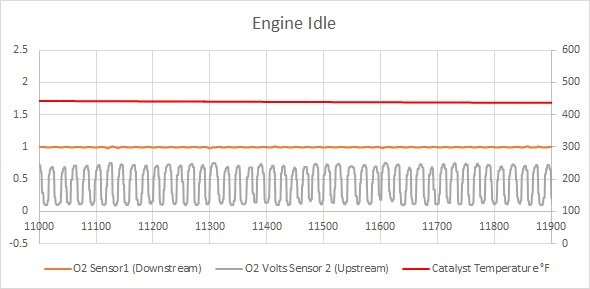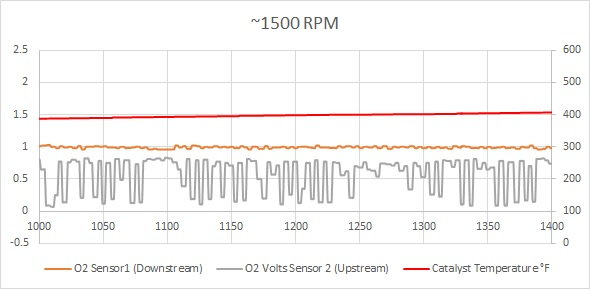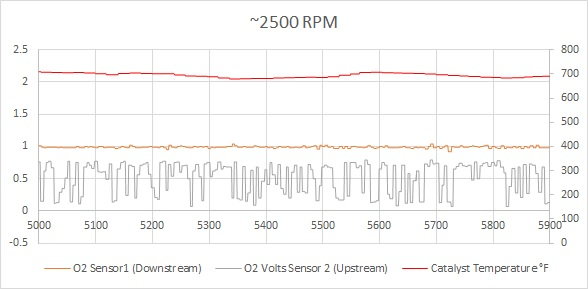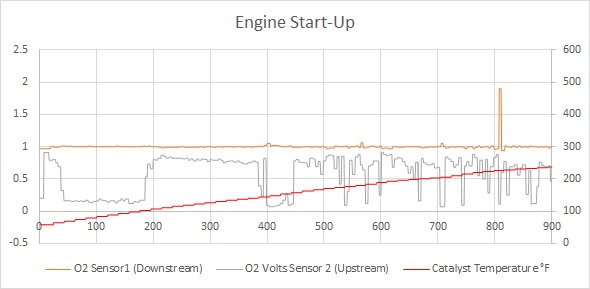Diagnosing P0420 Code with Torque App (need help)
#1
Diagnosing P0420 Code with Torque App (need help)
Hello Honda Fit Brain Trust,
I need some help analyzing some data I collected from my 2007 honda fit using my OBDII scan tool and the Torque app.
For some background, my car came up with a P0420 code (Catalyst System Efficiency Below Threshold) after my car experienced a series of massive misfires. More on that here: https://www.fitfreak.net/forums/1st-...-resolved.html
I read up on how catalytic converters work and how to read O2 sensor data but I'm an amateur (it will show in this post) so I need some help.
The following data was collected over two trips, approximately 30 minutes each. What I'm looking for is a nice consistent wave pattern in the upstream sensor (which was just replaced so I know it's accurate) and a relatively smooth line coming from the downstream sensor.
So after warming up the engine this is what I'm finding at Idle:

I get a nice even wave form that averages to about 0.45v on the upstream and an even line at 1.0v on the upstream.
I get the same pattern at higher loads:


The upstream wave pattern is a little choppy at the higher RPMs because the RPM fluctuates a little bit. After all, this is an actual driving test and not me reving the engine in my driveway.
So the sensor data seems to suggest that I have a well-functioning catalytic converter, right? The upstream sensor is nicely tracking to the variations in fuel trim, the converter is reaching an operating temperature of 600-800 degrees and, as a result, the gases exiting the converter are effectively *converted* to carbon dioxide and carbon monoxide (among other things), right?
Well, the check engine light is telling a different story: P0420.
Then I realized that the converter is only doing its job effectively when it is at operating temperature (a.k.a. when it "lights-off"). Meaning the downstream sensor should draw a similar pattern to the upstream when the converter is cold. That is when the catalytic converter isn't hot enough to break apart the NOx molecules.
So I took the same reading at start up:

hmm, well, I could be wrong but, shouldn't I see some more activity in the downstream sensor when the catalyst temperature is below 200 degrees?
Another thing, under normal operation, should the downstream sensor be giving a one-volt signal? I know the voltage varies on different vehicles but this seems high.
I also noticed that the downstream sensor tends to give quite a bit of noise. This might be expected when the RMPs are inconsistent but, just to illustrate my point, this is what happened when I was slogging through traffic:

So, can I definitively conclude that I have a broken downstream sensor? Or should I check elsewhere to find the source of the P0420?
I need some help analyzing some data I collected from my 2007 honda fit using my OBDII scan tool and the Torque app.
For some background, my car came up with a P0420 code (Catalyst System Efficiency Below Threshold) after my car experienced a series of massive misfires. More on that here: https://www.fitfreak.net/forums/1st-...-resolved.html
I read up on how catalytic converters work and how to read O2 sensor data but I'm an amateur (it will show in this post) so I need some help.
The following data was collected over two trips, approximately 30 minutes each. What I'm looking for is a nice consistent wave pattern in the upstream sensor (which was just replaced so I know it's accurate) and a relatively smooth line coming from the downstream sensor.
So after warming up the engine this is what I'm finding at Idle:
I get a nice even wave form that averages to about 0.45v on the upstream and an even line at 1.0v on the upstream.
I get the same pattern at higher loads:
The upstream wave pattern is a little choppy at the higher RPMs because the RPM fluctuates a little bit. After all, this is an actual driving test and not me reving the engine in my driveway.
So the sensor data seems to suggest that I have a well-functioning catalytic converter, right? The upstream sensor is nicely tracking to the variations in fuel trim, the converter is reaching an operating temperature of 600-800 degrees and, as a result, the gases exiting the converter are effectively *converted* to carbon dioxide and carbon monoxide (among other things), right?
Well, the check engine light is telling a different story: P0420.
Then I realized that the converter is only doing its job effectively when it is at operating temperature (a.k.a. when it "lights-off"). Meaning the downstream sensor should draw a similar pattern to the upstream when the converter is cold. That is when the catalytic converter isn't hot enough to break apart the NOx molecules.
So I took the same reading at start up:
hmm, well, I could be wrong but, shouldn't I see some more activity in the downstream sensor when the catalyst temperature is below 200 degrees?
Another thing, under normal operation, should the downstream sensor be giving a one-volt signal? I know the voltage varies on different vehicles but this seems high.
I also noticed that the downstream sensor tends to give quite a bit of noise. This might be expected when the RMPs are inconsistent but, just to illustrate my point, this is what happened when I was slogging through traffic:
So, can I definitively conclude that I have a broken downstream sensor? Or should I check elsewhere to find the source of the P0420?
Last edited by gadfly; 07-24-2015 at 05:36 PM.
Thread
Thread Starter
Forum
Replies
Last Post
xenocide702
Fit DIY: Repair & Maintenance
3
07-05-2016 03:38 PM
Paul.meybaum@mts.com
Fit DIY: Repair & Maintenance
35
01-18-2014 02:08 AM




